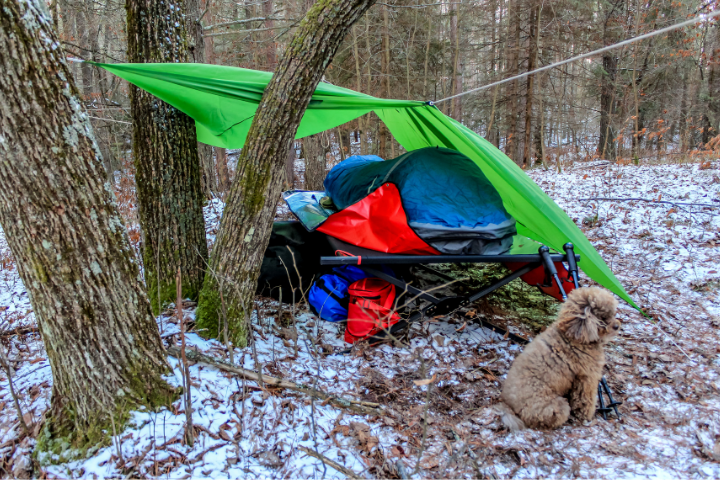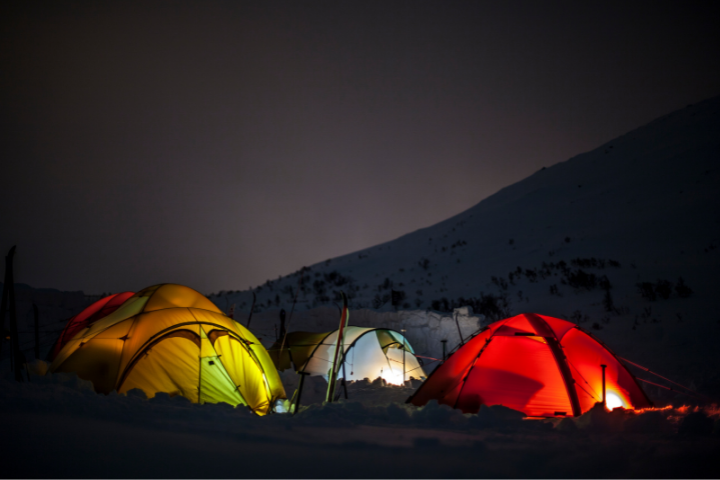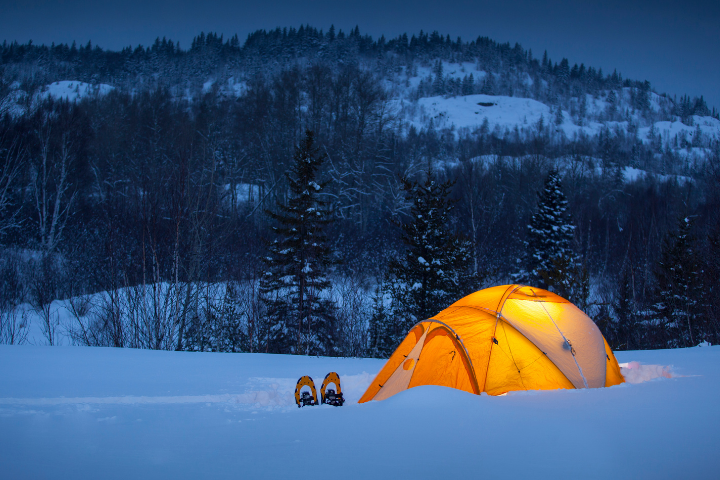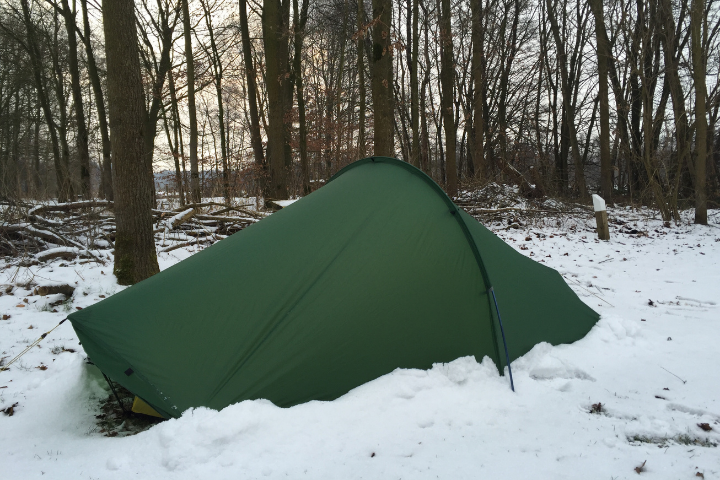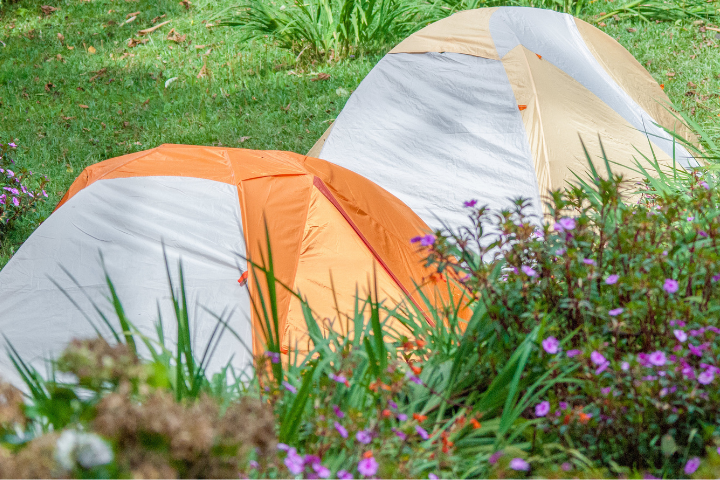12 Tips On How To Insulate A Tent For Winter Camping
Wondering how to insulate a tent for winter camping? Follow the steps below and learn the art of insulating your camp!
Camping during the winters may seem a cool idea, but staying warm during camping can be challenging. From facing high winds, snowfall to cold temperatures, everything and anything is against you, which will make your stay a lot more difficult than you think.
But, we tell you that there is a way out, and you can survive the cold by insulating your tent to face all the conditions. We have composed a list of tips that will allow you to insulate your tent and enjoy your winter camping expedition.
t Before We Dive Into the List, Let’s Understand How Insulation Works.
The working of insulation is pretty simple. One needs to create a barrier that reduces heat transfer between two materials, which is possible through conduction and radiant effects.
In simple terms, one should trap body heat inside their tents rather than heating the tent using heaters. Human bodies release energy that is equal to the energy produced by a 100W light bulb.
As tents are small and enclosed, only two areas require insulation, the floor and the walls, so body heat is the best way to heat the tent.
You might also like to read : How To Make Your Winter Sleep System: Complete Guide
Best Materials For Tent Insulation.
#1 Use Air
In heat transfer, one should look for materials that aren’t packed tightly at the molecular level, basically, something that isn’t dense; that is to say, the common way of insulating the tent is to use air.
Most insulating materials available today have air instead of solid material (the air is present in tiny pockets).
#2 Reflective foam for heat insulation.
Foam insulations usually adopt the trapped gases method (these gases are less dense than the air, thus allowing the tent to stay cool.
Another way of using foam insulation is to use air bubble reflective foil, and it works in the same manner as reflective foam.
#3 Get a tent that works during all seasons.
If you are an avid camper, then I’m sure you must be aware of how great 4 season tents are, but if you are new, you need to keep in mind that getting camping gear is suitable for snow and cold. Though this isn’t the way of insulating a tent, carrying a 4 season tent will keep you warm at night.
Another reason you should opt for a four-season tent instead of others is the construction of the tent body; apart from a four-season tent, all other tents have canopies made of mesh, and they allow great breathability, especially during the summer months.
But in a four-season tent, you are going to stay warm at night. Four-season tents are also made up of thicker fabrics, which means the tent will stay insulated, and you will stay relatively warm during cold nights.
#4 Buy a smaller tent, maybe?
Apart from buying a four-season tent, buy tents that are smaller in size, especially if you are planning winter camping.
Having extra space is good, but when you are winter camping, using a six-person tent when only four people are camping will be a headache as you would have to heat the extra space too.
Choose a smaller tent during winter camping, you won’t have to heat extra space, and you can enjoy your winter camping.
#5 Buy a tarp
Strong winds are common during the winter months, and they may wreak havoc on your nighttime warmth. While chilly air temperatures are typically a concern during winter camping, windy weather is sometimes greater when staying warm in the mountains.
In fact, due to the effects of wind chill, even a small breeze may turn a reasonably pleasant winter day into a chilly night in your sleeping bag. So, if you want to avoid restless nights throughout the winter months, you’ll need to discover measures to shield yourself from the wind.
In addition, in your tent’s rainfly, you could attempt pitching a tenting tarp withinside the route of the triumphing winds to forestall cold air from infiltrating your tent. That way, you could get your splendor rest while strong gusts of wind sweep via your campsite at night.
You might also like to read : Setting up a Winter Campsite
#6 Snow can be used to create a windbreak.
If you’re camping in really cold weather, building a big snow wall around your tent is an excellent alternative to using a tarp as a windbreak.
Snow walls are generally more durable and effective than tents, and they may be used at night to keep drifting snow from building up on the side of your shelter.
Of course, the quantity of snow available in your camping area will determine your capacity to create a windbreak, but even with only 2 to 3 feet (60 to 90cm) of snow on the ground, you can usually make a substantial wall.
#7 Use a thermal blanket.
Because hot air rises and cold air descends, draping a thick insulating garment, such as a thermal blanket, over the top of your tent can help keep your body heat from escaping into the chilly winter night.
Covering the pinnacle of your tent with a massive thermal blanket or a few different types of warmness-reflective material, like an area blanket, can assist entice to your frame warmness for the delivered warm temperature at night.
#8 Using insulating fabric
Consider lining the ceiling of your tent with greater insulating cloth in case you find out that masking the pinnacle of your tent with a thermal blanket isn’t always sufficient to hold you heat during wintry weather camping.
You have some great options for insulation and partitions of the tent, relying on its size. Cutting up portions of an area blanket and using them to line the indoors of your tent might be the best technique.
If you need to take your internal insulation to the subsequent level, visit your neighborhood hardware store and search for sheets of insulated fabric or paneling. This form of insulation is extra possible for automobiles camping-primarily based on total journeys because of the burden and length of those products.
#9 Make a footprint on your tent.
You’ll need to pay greater care to defend your tent from the bloodless, damp floor, similar to the pinnacle of your tent.
A tent footprint or groundsheet is a primary and clear-cut method to insulate your tent from the floor. Tent footprints are large strips of water-proof material that offer a further layer of safety among you and the frozen floor withinside the iciness.
You might also like to read : How to Keep Your Tent Warm and Cozy This Winter
Most tent producers create and promote their custom-constructed footprints, custom-reduce to shape a given tent’s precise pattern. If you cannot discover a footprint constructed particularly on your tent, you could constantly use a trendy tenting tarp.
Remember that the groundsheet has to cover the entire ground of your tent; otherwise, moisture and coffee temperatures will sneak in via any gaps. If in any respect feasible, have a footprint that covers the vestibule place of your tents so that you might also additionally keep your stuff in clean, dry surroundings at night time.
#10 To insulate the ground, use foam cushioning.
While footprints and groundsheets defend and insulate your tent from the elements, you could additionally insulate your refuge from the inner.
Covering your tent ground with large portions of foam cushioning is a reachable and moderately less expensive approach to obtain this. Although you may be sleeping on a snoozing pad or a cot, insulating the ground of your tent with foam will help decrease warmth transmission out of your tent to the bloodless floor.
This is mainly crucial for folks who sleep on snoozing pads because they’re more liable to the cooling results of underlying snow or the bloodless, frozen floor.
#11 Rugs or carpets are great.
You might also additionally use large rugs or quantities of antique carpet to line the ground of your snoozing area to insulate the ground of your tent even greater all through the icy months.
While carpets and rugs no longer provide the identical stage of herbal insulation as foam padding, they can offer a few greater warm temperatures at some point in the icy months. Plus, even on totally bloodless nighttime withinside the woods, they assist your tent cozy and snug.
If you have no extra rugs or carpets on hand, you could line the ground of your tent with blankets at night time. If you decide to apply blankets, hold in mind that they are not as long-lasting as carpets or rugs, so be cautious to avoid accidental harm while transferring around your tent.
#12 Consider the use of a tent heater.
If you have very well insulated the outside and indoors of your tent from the cold iciness climate, however nevertheless cannot get heat at night time, a tent heater can be well worth thinking about on your subsequent tenting trip.
Tent warmers are available in numerous options and sizes, so there are many options to pick from. You may additionally choose between gas-powered and electric-powered versions, permitting you the liberty to pick the electricity supply that first-rate fits your iciness tenting style.
On the other hand, tent warmers are dangerous if not used appropriately. These warmers might also get pretty warm to the touch, and gas-powered ones have open flames that may purpose a hearthplace or launch carbon monoxide. As a result, all tent heater protection precautions need to constantly be taken.
Finally, a tenting range isn’t a possible replacement for a tent heater designed particularly for that purpose. While tenting stoves are outstanding at what they do (i.e., getting ready camp meals), they lack the protection measures that a tent heater provides.
While it could seem that the use of a range for a couple of minutes to feature a few greater warmth in your tent is OK, studies indicate that doing so appreciably will increase your danger of sickness.
Answers To More Questions About Tent Insulation
How do you Winter Proof a tent?
There are many ways of Winter Proofing a tent, but the best bet is to get a Four season tent, which will work in every season.
Can you insulate a camping tent?
Yes, you definitely can insulate a camping tent. There are many ways to use rugs, blankets, insulating fabrics, etc. Use any of the ways mentioned above, and your tents will be insulated.
How do I keep my camping tent warm in the winter?
You can keep your camping tents warm by using a tent heater, rugs, basically by following all the tips as mentioned above, and your tent will stay warm during the winter.
How do I keep my camping tent warm?
You can keep your camping tent warm by following all the listed methods stated above.
Wrap Up
There are many ways of keeping your tent warm, and we have tried to mention every method above; follow the one which suits you the best, and you are good to go.
